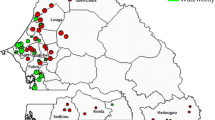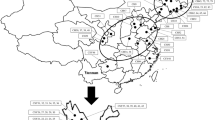Abstract
Maize (Zea mays L.) harbours significant genetic diversity not only in its centre of origin (Mexico) but also in several countries worldwide, including India, in the form of landraces. In this study, DNA fingerprinting of 48 landrace accessions from diverse regions of India was undertaken using 42 fluorescent dye-labeled Simple Sequence Repeat (SSR) markers, followed by allele resolution using DNA sequencer and analysis of molecular diversity within and among these landraces. The study revealed a large number of alleles (550), with high mean number of alleles per locus (13.1), and Polymorphism Information Content (PIC) of 0.60, reflecting the level of diversity in the landrace accessions. Besides identification of 174 unique alleles in 44 accessions, six highly frequent SSR alleles were detected at six loci (phi014, phi090, phi112, umc1367, phi062 and umc1266) with individual frequencies greater than 0.75, indicating that chromosomal regions harboring these SSR alleles are not selectively neutral. F statistics revealed very high genetic differentiation, population subdivision and varying levels of inbreeding in the landraces. Analysis of Molecular Variance showed that 63 % of the total variation in the accessions could be attributed to within-population diversity, and 37 % represented between population diversity. Cluster analysis of SSR data using Nei’s genetic distance and UPGMA revealed considerable genetic diversity in these populations, although no clear separation of accessions was observed based on their geographic origin.

Similar content being viewed by others
Abbreviations
- PIC:
-
Polymorphism Information Content
- AMOVA:
-
Analysis of Molecular Variance
- UPGMA:
-
Unweighted Pair Group Method using Arithmetic means
- H o :
-
Observed heterozygosity
- H e :
-
Expected heterozygosity
- F :
-
Inbreeding coefficient
- A :
-
Number of alleles per locus
- A e :
-
Effective number of alleles
- GD:
-
Genetic distances
- SSR:
-
Simple sequence repeat
- SNP:
-
Single nucleotide polymorphism
References
Berg EE, Hamrick JL (1997) Quantification of genetic diversity at allozyme loci. Can J Forest Res 27:415–424
Daniels J, Holmans P, Williams N, Turic D, McGuffin P, Plomin R, Owen MJ (1998) A simple method for analyzing microsatellite allele image patterns generated from DNA pools and its application to allelic association studies. Am J Hum Genet 62:1189–1197
R Development Core Team (2005) R: a language and environment for statistical computing. R Foundation for Statistical Computing, Vienna, Austria (http://www.R-project.org)
Dubreuil P, Warburton M, Chastanet M, Hoisington D, Charcosset A (2006) More on the introduction of temperate maize into Europe: large-scale bulk SSR genotyping and new historical elements. Maydica 51:281–291
Elshire RJ, Glaubitz JC, Sun Q, Poland JA, Kawamoto K, Buckler ES, Mitchell SE (2011) A robust, simple genotyping-by-sequencing (GBS) approach for high diversity species. PLoS One 6:e19379
Eschholz TW, Peter R, Stamp P, Hund A (2008) Genetic diversity of Swiss maize assessed with individuals and bulks on agarose gels. Genet Resour Crop Evol 55:971–983
Excoffier L, Laval G, Schneider S (2005) Arlequin version 3.1: an integrated software package for population genetics data analysis. Evol Bioinformatics Online 1:47–50
Gomez OJ, Matthew W, Blair P, Bodil E, Frankow-Lindberg C, Urban G (2004) Molecular and phenotypic diversity of common bean landraces from Nicaragua. Crop Sci 44:1412–1418
Henderson ST, Petes TD (1992) Instability of simple sequence DNA in Saccharomyces cerevisiae. Mol Cell Biol 12:2749–2757
Joshi PK, Singh NP, Singh NN, Gerpacio RV, Pingali PL (2005) Maize in India: production system. Constraints and Research Priorities, CIMMYT, Mexico DF
Kimura M, Crow JR (1964) The number of alleles that can be maintained in a finite population. Genetics 49:725–738
LeDuc C, Miller P, Lichell J, Parry P (1995) Batched analysis of genotypes. PCR Methods Appl 4:331–336
Liu K, Muse SV (2005) PowerMarker: an integrated analysis of environment for genetic marker analysis. Bioinformatics 21:2128–2129
Matsuoka Y, Vigouroux Y, Goodman MM, Sanchez GJ, Buckler E, Doebley JA (2002) Single domestication for maize shown by multilocus microsatellite genotyping. Proc Natl Acad Sci USA 99:6080–6084
Nass LL, Pellicano IT, Valois ACC (1993) Utilization of genetic resources for maize and soybean breeding in Brazil. Brazilian J Genet 16:983–988
Nei M (1972) Genetic distance between populations. Am Natur 106:283–292
Page RDM (1996) TREEVIEW: an application to display phylogenetic trees on personal computers. Comput Appl Biosci 12:357–358
Perlin MW, Lancia G, Ng SK (1995) Towards fully automated genotyping: genotyping microstatellite markers by deconvolution. Am J Hum Genet 57:1199–1210
Prasanna BM (2010) Phenotypic and molecular diversity of maize landraces: characterization and utilization. Indian J Genet 70:315–327
Prasanna BM (2012) Diversity in global maize germplasm and novel initiatives for characterization and utilization. J Biosci 34 (In Press)
Prasanna BM, Sharma L (2005) The landraces of maize (Zea mays L.): diversity and utility. Indian J Plant Genet Resour 18:155–168
Prasanna BM, Vasal SK, Kassahun B, Singh NN (2001) Quality protein maize. Curr Sci 81:1308–1319
Prasanna BM, Pixley K, Warburton ML, Xie CX (2010) Molecular marker-assisted breeding options for maize improvement in Asia. Mol Breed 26:339–356
Pressoir G, Berthaud J (2004) Patterns of population structure in maize landraces from the Central Valleys of Oaxaca in Mexico. Heredity 92:88–94
Qi-Lun Y, Ping F, Ke-Cheng K, Guang-Tang P (2008) Genetic diversity based on SSR markers in maize (Zea mays L.) landraces from Wuling mountain region in China. J Genet 87:287–291
Rebourg C, Gousnard B, Charcosset A (2001) Large scale molecular analysis of traditional European maize populations: relationships with morphological variation. Heredity 86:574–587
Rebourg C, Chastanet M, Gouesnard B, Welcker C, Dubreuil P, Charcosset A (2003) Maize introduction into Europe: the history reviewed in the light of molecular data. Theor Appl Genet 106:895–903
Reif JC, Xia XM, Melchinger AE, Warburton ML, Hoisington D, Beck D, Frisch M (2004) Genetic diversity determined within and among CIMMYT maize populations of tropical sub tropical and temperate germplasm by SSR markers. Crop Sci 44:326–334
Ribaut J-M, Hoisington DA, Deutsch JA, Jiang C, Gonzalez-de-Leon D (1996) Identification of quantitative trait loci under drought conditions in tropical maize: 1. Flowering parameters and the anthesis-silking interval. Theor Appl Genet 92:905–914
Sharma L, Prasanna BM, Ramesh B (2010) Phenotypic and microsatellite-based diversity and population genetic structure of maize landraces in India, especially from the North East Himalayan region. Genetica 138:619–631
Singh B (1977) Races of maize in India. Indian Council of Agricultural Research (ICAR), New Delhi
Warburton ML, Xianchun X, Franco J, Melchinger AE, Frisch M, Bohn M, Hoisington D (2002) Genetic characterization of CIMMYT inbred maize lines and open pollinated populations using large scale fingerprinting methods. Crop Sci 42:1832–1840
Warburton ML, Wilkes G, Taba S, Charcosset A, Mir C, Bedoya C, Prasanna BM, Xie CX, Hearne SH, Franco J (2011) Gene flow between different teosinte species and into the domesticated maize gene pool. Genetic Resour Crop Evol 58:1243–1261
Yeh FC, Yang RC, Boyle TBJ, Ye ZH, Mao JX (1997) POPGENE, version 1.2, Molecular Biology and Biotechnology Centre, University of Alberta, Edmonton
Acknowledgements
The study was undertaken as a part of the ICAR National Fellow Project (2005–2010) awarded to BMP. The authors thank the Division of Germplasm Conservation, NBPGR, New Delhi (especially Dr Kalyani Srinivasan) for providing seed material of some landrace accessions used in this study.
Author information
Authors and Affiliations
Corresponding author
Rights and permissions
About this article
Cite this article
Wasala, S.K., Prasanna, B.M. Microsatellite marker-based diversity and population genetic analysis of selected lowland and mid-altitude maize landrace accessions of India. J. Plant Biochem. Biotechnol. 22, 392–400 (2013). https://doi.org/10.1007/s13562-012-0167-5
Received:
Accepted:
Published:
Issue Date:
DOI: https://doi.org/10.1007/s13562-012-0167-5




